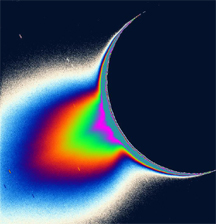Geotimes

Untitled Document

News Notes
Planetary geology
Tiny moon, gigantic geyser
 A tiny moon
of Saturn, no larger than England, is changing researchers’ notions about
which celestial bodies can support geologic activity. New, closer images of
Enceladus have confirmed that a plume, noticed in previous images, is indeed
an enormous geyser emanating from visible cracks in the moon’s surface.
A tiny moon
of Saturn, no larger than England, is changing researchers’ notions about
which celestial bodies can support geologic activity. New, closer images of
Enceladus have confirmed that a plume, noticed in previous images, is indeed
an enormous geyser emanating from visible cracks in the moon’s surface.
In this color-enhanced image, an enormous
plume emanating from fractures on Saturn’s moon Enceladus appears backlit
by the sun. Astronomers were surprised to find geologic activity on the small
moon, which is seven times smaller than Earth’s moon. Image courtesy of
NASA/JPL/Space Science Institute.
NASA’s Cassini spacecraft first revealed the plume-like feature in images
taken in January and February last year. But according to Carolyn Porco, Cassini
imaging team leader at the Space Science Institute in Boulder, Colo., speculation
remained that the feature was an artifact of the camera. Following a special
Cassini mission in November to take a closer look, however, the images “confirmed
it without question,” Porco says.
The moon and its plume look similar to a comet and its tail, which forms from
vapor created when sunlight warms the icy body. Enceladus, however, does not
receive much sunlight. Instead, pressurized vapor on Enceladus emanates from
below the surface and “shoots out like a jet” through vents the team
calls tiger stripes, Porco says. She describes the vapor’s composition
of small icy particles to be “like the finest powder you might ski on in
Utah.” The cause of the pressurized geyser, Porco says, is due to an internal
source of heat on the moon, either from flexing tides or from radioactive material.
Small bodies such as Earth’s moon, which is 3,476 kilometers in diameter,
typically lose their internal heat shortly after formation, rendering them geologically
dead. Porco says that even though she was not surprised to find geologic activity
on Enceladus, she finds it “thrilling” to see geologic activity on
another body — especially a moon only 480 kilometers in diameter, with
a geyser as tall as the moon is wide. Finding activity on such a small body,
Porco says, “has torqued our ideas around about how geologic activity can
come about.”
Kathryn Hansen
Back to top
Untitled Document

 A tiny moon
of Saturn, no larger than England, is changing researchers’ notions about
which celestial bodies can support geologic activity. New, closer images of
Enceladus have confirmed that a plume, noticed in previous images, is indeed
an enormous geyser emanating from visible cracks in the moon’s surface.
A tiny moon
of Saturn, no larger than England, is changing researchers’ notions about
which celestial bodies can support geologic activity. New, closer images of
Enceladus have confirmed that a plume, noticed in previous images, is indeed
an enormous geyser emanating from visible cracks in the moon’s surface.

